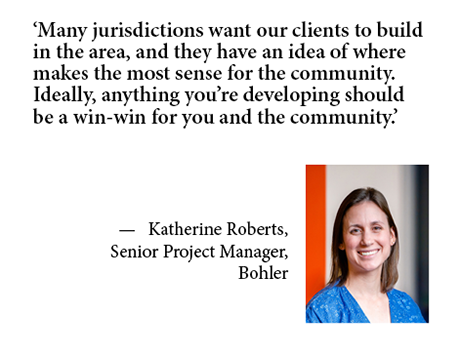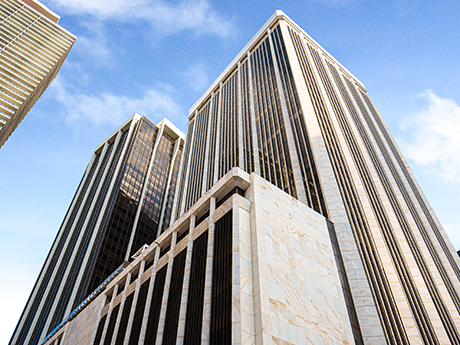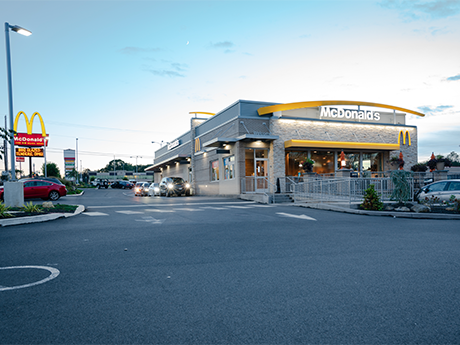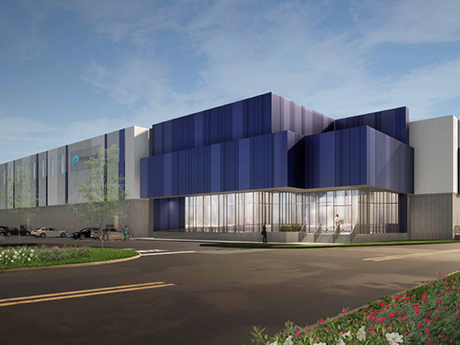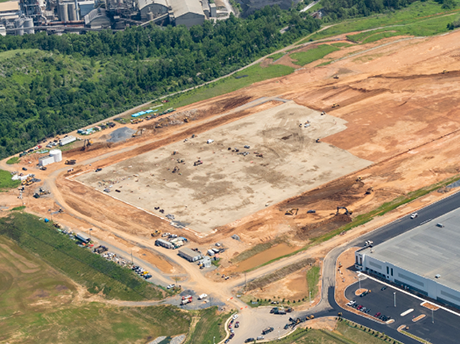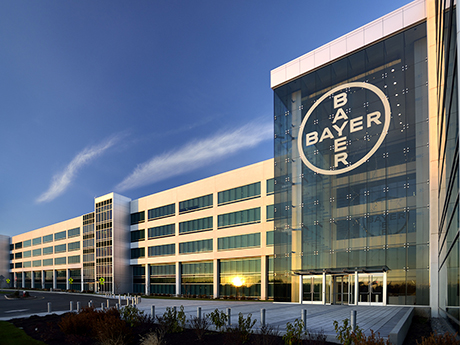Life sciences-anchored innovation districts are becoming increasingly popular as hubs for research and development in the biotech and pharmaceutical industries. These districts, also known as “innovation districts,” are characterized by clusters of companies, research institutions, supporting organizations, living areas, amenities and offices all located in close proximity. This grouping requires detailed planning and design strategies to maximize their potential for scientific exploration and success on an enormous, ambitious scale. Master planning and engaging site civil engineering partners early on in the process can save time and money once a project reaches the design stage. This article is the first installment in a two-part series on life sciences innovation districts to discuss, first, the planning, and, then, the design elements required by these districts. Read about design in Part 2, here. Fostering innovation, collaboration and productivity is at the heart of planning for life sciences innovation districts. The successes of famous examples such as North Carolina’s Research Triangle Park, Kendall Square in Cambridge, Mass. and Mission Bay in San Francisco indicate how beneficial a melting-pot mix of residential, commercial and research spaces can be when they concentrate talent from research institutions, life sciences innovators, universities and the surrounding community. “Many life …
Bohler
As vacant sites become rare and cost-prohibitive, commercial real estate developers need to be creative when it comes to bringing a new project out of the ground. Unconventional development sites offer cost savings and location advantages, and in-depth due diligence and creativity on the part of developers can make for sites that can allow an elegant union of lower costs and strategy. With limited room for delay, how can developers think critically about available sites and leverage existing conditions to their advantage? Katherine Roberts, senior project manager at Bohler’s Warrenton, VA office, and Gregory Roth, principal at Bohler’s Tampa office, offer their expert advice on threading this needle. Bohler specializes in land development, especially making development work when conventional sites aren’t an option. Prioritizing Development Needs When Assessing Red Flags Certain project factors can be red flags if time or cost are obstacles to a developer, including These points of concern are usually knots that can be untangled if a developer has the time, money and appetite to move forward in spite of these interruptions, but each factor does bear watching. “Developers should understand where their limits are and where they’re willing to negotiate. Ideally, anything you’re developing should be …
MIAMI — CP Group and PCCP LLC have added 14 new office tenants to join One Southeast Third Avenue, a 31-story office tower in downtown Miami. The new tenants span multiple industries, including real estate, legal and tech, and combined represent 47,533 square feet in new leases. Additionally, Bohler, a civil engineer firm, has expanded its footprint at the 440,000-square-foot building, which was formerly known as SunTrust International Center. Cristina Glaria, Harrison Mischel, Jon Blunk and Laurel Oswald of TCRE represented CP Group and PCCP in all leasing negotiations. In addition to traditional office space, One Southeast Third Avenue offers three floors of CP Group’s worCPlaces flexible office concept for tenants and entrepreneurs seeking short-term accommodations. Additionally, another floor of speculative suites is currently being built out at the tower.
Data Center Developers Consider Unconventional Sites, Streamlining Strategies to Meet Immense Demand
Data center development is simultaneously growing by leaps and bounds as well as suffering from its own success. The easy-to-develop sites have been snapped up and demand for additional data and cloud services continues to grow, forcing developers to look beyond the obvious locations for sites. This can entail running into less-than-obvious delays in the development process. Data centers reliably store and transmit the deluge of information that makes modern life possible. The factors driving the need for data centers — enterprise demand for cloud services, dependence on 5G cell networks, artificial intelligence technology, edge computing capabilities, social media use and streaming needs — will continue to grow exponentially in the coming years. According to a September 2022 report by advisory company Arizton, approximately 2,825 megawatts of power capacity will be added to the data center market in the next five years. The same report forecasts the U.S. data center construction market will reach $25 billion by 2027, up from $20 billion in 2021. Data centers are utility-intensive property types, and the sites that can support their formidable power, communication and water needs often require high-level considerations right from the start. How can the development process for such projects be streamlined …
BohlerContent PartnerDevelopmentFeaturesIndustrialMidwestMultifamilyNortheastOfficeRetailSoutheastTexasWestern
Retail Development Program Lessons Apply Across Property Types
Retail development programs have allowed retailers to streamline their goals by creating prototype models based on site particulars. This process saves developers and retailers money as they can be flexible in choosing models that work for each site without needing to alter layouts and features too much between builds. But what makes for successful prototypes and program standards? Can this approach work outside of the retail world? “The lessons of retail programs can apply across property types in this sense: land development consultants and site designers can learn how specific clients need their set of standards and guidelines implemented. It’s essential to thoroughly understand a program client’s procedures, and we’re expected to know these parameters inside and out,” says Steven T. Fortunato, a senior project manager at Bohler’s Rehoboth Beach office in Delaware. Bohler is a land development design and consulting firm that specializes in helping developers move their projects forward faster. “The retail program methodology translates well to other sectors. Starting off with either a new developer or a new client is an opportunity to learn their standards — or help the client create them. The end result must offer the same level of confidence whether the product is retail or …
NORTH BRUNSWICK, N.J. — General contractor Peak Construction is underway on Crossroads Commerce Center, a 191,481-square-foot industrial project located in North Brunswick, about 40 miles south of New York City. Building features will include a clear height of 40 feet, 130-foot truck court depths, 29 dock positions, two drive-in doors, 161 car parking spaces and 31 trailer parking spaces. Principal Asset Management is the developer of the project. Other project partners include construction manager D. Loeffler Consulting, Environetics Group Architects and Bohler Engineering. Completion is slated for May 2023.
Can you dig it? Possibly, but site civil engineers can help determine if construction can rock on without running into rocky situations. Thorough site civil due diligence is the foundation for developing a project with minimal delays. Keeping land development projects moving forward — especially during construction — requires highly informed due diligence processes and expertise when it comes to approvals and plans. Site civil engineering design with constructability in mind can support general contractors while streamlining the overall bidding and construction process. But what are best practices when it comes to ensuring a successful project? REBusinessOnline spoke to two experts who specialize in high-quality construction documents: Benjamin Plumb, P.E. project manager, and Keith Simpson, director of engineering, work for Bohler, a land development consulting and technical design company. You Never Know What You’ll Find Before You Dig — However, These Tips Can Help Uncertainty is part of any development project, but Simpson outlines two scenarios that make up the majority of the challenges he sees: 1. Existing underground utilities that are not reflected in plans. 2. Soils that differ from what was expected from the geotechnical report. In some cases, slowdowns are unavoidable and will cause delays, but due diligence can …
Combinations of offices with laboratories, research and development spaces and/or manufacturing areas make life sciences facilities highly customizable. These multipurpose, technical spaces are in high demand from companies seeking first-class facilities for research-based advancements. Low vacancies, high rents and the chance to convert unused office or retail spaces on a faster timeline have prompted some creative approaches to retrofit existing space to fulfill the needs of science and technology tenants. In other instances, facilities must be built from the ground up to conform to best practices. But what factors matter most to the life sciences field? And how can developers increase their speed to market? Read on for tips and checklists for developers hoping to speed up the process of building or retrofitting these facilities. Industry Drivers: Speed to Market and Flexibility Office conversions into life sciences facilities offer a variety of options. Life sciences facilities often do not need to accommodate large trucks (eliminating circulation and loading dock concerns), they use office components and (most importantly) office conversions offer faster speed to market than other types of conversions. “Speed to market is most important for these developers/tenants. There is a shortage of space, so a well-designed, spec building will …
BohlerContent PartnerDevelopmentFeaturesLeasing ActivityMidwestMultifamilyNortheastSoutheastTexasWestern
Multifamily Developers Must Find Balance Between Density, Amenities
Finding a balance between density and amenities has never been simple for residential developers, but rising interest rates, density restrictions and an increased desire to solidify multifamily projects within the community mean that there is much to be gained from creative approaches to this old problem. Starting the process of planning early, using zoning to the developer’s advantage and creating an adaptable, sustainable and welcoming place for tenants can allow for a successful project with a lower overall price tag. This method can solve some of the trickier problems faced by multifamily developers, including density, parking and zoning considerations. Starting Off Right — Creating a Master Site Plan Success in multifamily is easier to achieve if the project starts with a shared team vision from the outset, says Bill Rearden, principal at Bohler, a land development design and consulting firm. Rearden explains that Bohler has its own planning, landscape architecture and survey teams and works with many industry partners for environmental and geotechnical due diligence. “We work with these teams in the very early stages to understand what the configuration of a property is and what its constraints are. We know upfront any underlying zoning a property might have, so …
Developers have seen permitting and entitlement timelines lengthen exponentially over the past few years. What is causing increased timelines and how do developers overcome challenges and avoid unnecessary delays? If expanded timelines are inevitable in some cases, how can developers ensure that slowdowns do not spread to other aspects of development? Many municipalities have been overwhelmed by an explosion in projects and applications in the development queue, and the issues are compounded by employee turnover within these organizations. Municipal slowdowns in upgrading utility capacities have further stalled the process of development. Additionally, the process for obtaining permits and entitlements has grown increasingly complex in certain regions, regardless of property type. REBusiness Online spoke with experts at Bohler, a land development design and consulting firm, to learn the best practices for keeping delays and budgets under control in the face of growing timeline uncertainties. To avoid problems before they begin, these experts recommend early due diligence and local expertise, as well as an approach that incorporates the community, local agencies and the authority having jurisdiction at crucial points. Bohler’s team also emphasizes the importance of working through waiting periods and working on different elements of a project concurrently, so that if …



